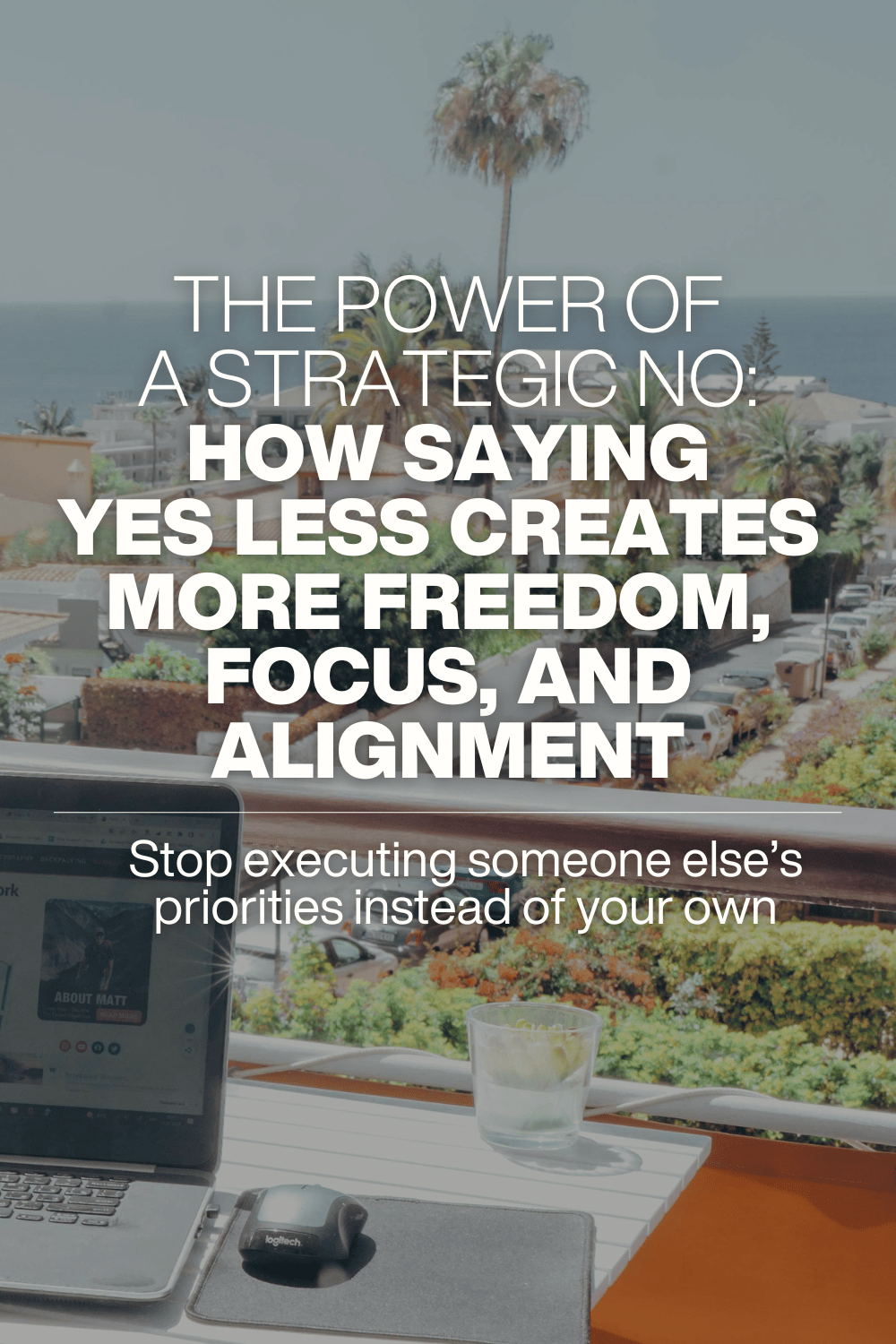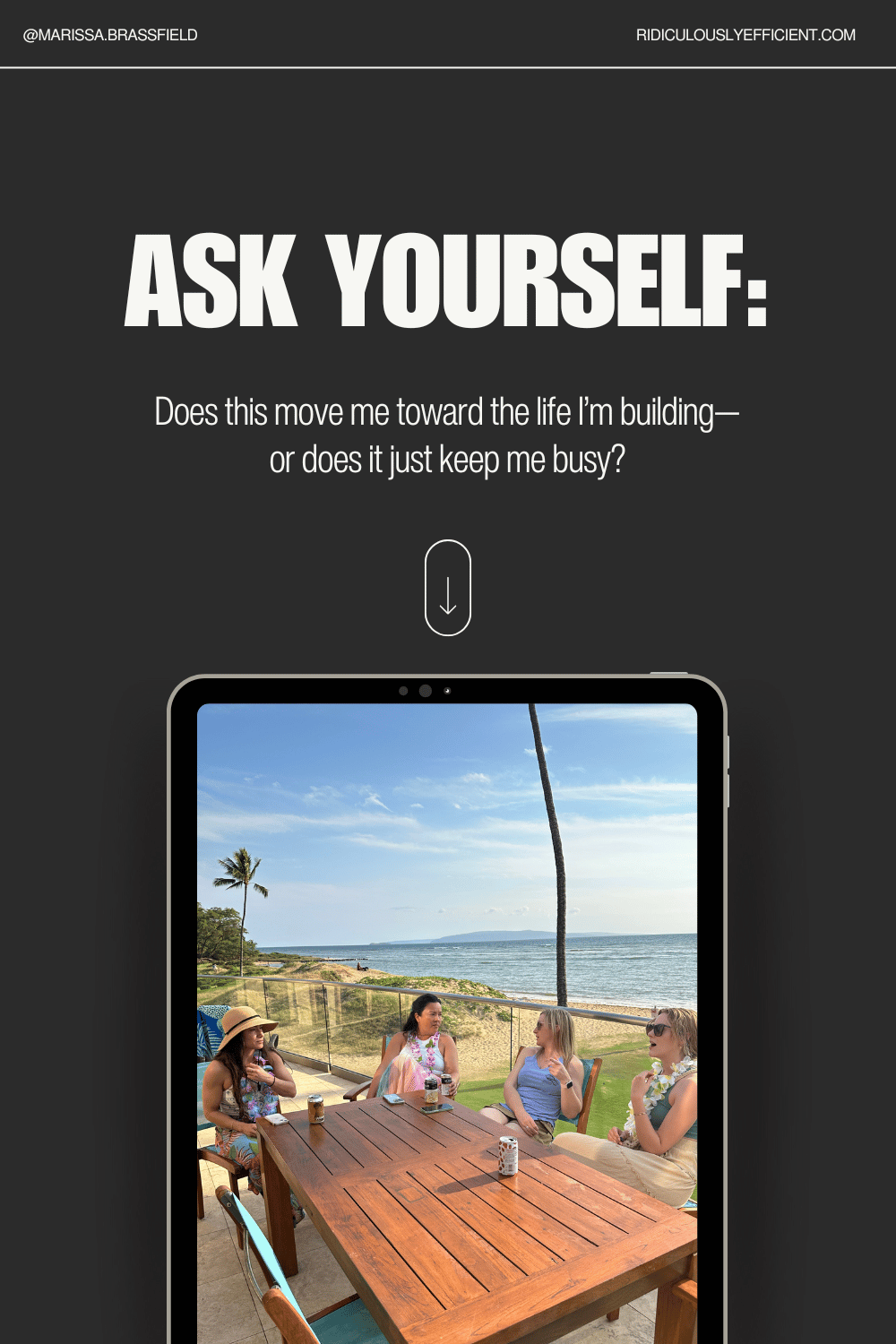
It started with a late-night text.
"We need you to join as co-founder. A16Z meeting is in two weeks. Equity package attached."
Seven figures. Hot startup. Prestigious investors.
By Sunday morning, he’d said no.
Not because the opportunity was bad. Because the cost was too high.
This is the real muscle most successful leaders develop over time:
They get elite at saying no.
Not from fear. Not from scarcity. But because they’ve learned that a "yes" isn't free.
Why We Default to Yes (and Why It’s Costing You)
We live in a culture that celebrates hustle, over-functioning, and always being "game." Say yes to every opportunity. Say yes to the pitch, the stretch assignment, the "quick favor." Say yes because you might miss out if you don’t.
But there’s a hidden cost to all that yes.
Most of us are constantly overdrafting our calendars, our energy, and our attention.
And if you’re a high-performing leader, founder, or creative who’s already holding a lot, those costs compound.
You say yes to short-term revenue, and no to long-term strategy.
You say yes to being needed, and no to being free.
You say yes to proving yourself, and no to protecting yourself.
At first, it feels generous. Then it becomes draining. Eventually, it’s unsustainable.
The good news? There’s another way. A sovereign way.
The Sovereignty Shift: When You Start Guarding Your Yes
Warren Buffett famously said: “The difference between successful people and really successful people is that really successful people say no to almost everything.”
There comes a point where successful people stop saying yes out of obligation and start saying no from alignment.
They realize:
- Time is finite.
- Energy is even more finite.
- Not everything deserves access.
They learn to treat their attention as their most valuable resource.
They stop giving it away freely and start asking: What’s the opportunity cost of this yes?
The Opportunity Cost Matrix
Before you say yes to a project, partnership, meeting, or favor, run it through this filter:
1. Time Cost
- What will this take time away from?
- Will this energize me or deplete me?
- Does this require maintenance after delivery?
2. Growth Cost
- Will this grow me in ways I want to grow?
- Is this building the next version of me—or distracting me from her?
- Am I doing this because I’m aligned, or because I’m available?
3. Freedom Cost
- Will this create more autonomy or more entanglement?
- Is this a leverage move or a labor trap?
- Am I choosing from abundance or from fear?
Strategic No: The Secret Weapon of Aligned Leaders
Here’s what elite, values-driven people know: being good at your craft isn’t enough.
You also need to be good at protecting the conditions that help you stay excellent.
Which often means saying no:
- To good offers that don’t align.
- To people who mean well, but drain you.
- To patterns that once served you but don’t anymore.
Instead of treating your brain like a machine, design it like a strategist—matching tasks to energy zones and batching thoughtfully.
Dive deeper into this concept in How to Organize Your Day by Energy, Not Time—it's where I walk you through tracking natural energy peaks and aligning your calendar with your biology
What Strategic No’s Actually Sound Like
Saying no doesn’t have to burn bridges. In fact, most of the time, it can build respect.
Here are a few ways to decline with clarity and care:
For misaligned opportunities:
"Thanks so much for thinking of me. This doesn’t align with my current priorities, but I’d be happy to recommend someone else."
For low-cash, high-equity offers:
"I believe in the vision. But this season, I’m focused on building sustainable cash flow—not taking on new equity positions."
For projects that expand beyond scope:
"I’m glad to support the original scope. If we’re expanding it, let’s explore a new agreement that supports the additional time and energy."
For not-right-now timing:
"This sounds promising. I’m fully committed through [date], but let’s reconnect in [future date] if you’re still looking."
The Compound Effect of Saying No
Here’s what happens when you start saying no on purpose:
Week 1: You feel guilty. You question whether you’re being difficult or closed off.
Month 1: You notice more space in your calendar and your head. You’re thinking again.
Quarter 1: New, more aligned opportunities start showing up. You feel more in control, more energized, more present.
Year 1: You realize everything you said no to wasn’t actually for you—it was clutter. And your “yeses” now hit so much harder.
This is what’s possible when you move from fear-based yes to values-based no.
Turning FOMO Into JOMO
The world says: "What if you miss something?"
But what if you gain something?
- Every no to a meeting is time for deep work.
- Every no to an event is an evening with your family.
- Every no to a shiny offer is space to build what actually matters to you.
Just start saying no strategically.
How to Practice Your Strategic No This Week
1. Audit your yeses. What are you currently committed to that no longer serves your energy or priorities?
2. Identify your boundaries. What time blocks, types of work, or people drain you—and what would it look like to protect your space?
3. Build your No Templates. Use the examples above or write your own. Save them. Practice saying them out loud.
4. Create your filter. Write 3 non-negotiables an opportunity must meet for you to say yes. Use this to check everything new.
5. Practice the pause. The next time someone makes a request, try: "Let me check my calendar and get back to you." This gives you space to respond with intention, not impulse.
Your Attention Is Sacred. Protect It Accordingly.
The world will always ask for more of you.
That doesn’t mean you have to give it.
Saying no isn’t about being difficult.
It’s about being directed.
When you protect your energy, you’re not just guarding your time—you’re protecting your future.
The next time an opportunity comes your way, ask yourself:
Does this move me toward the life I’m building—or does it just keep me busy?
You are not here to prove your worth through exhaustion.
You are here to lead with intention.
To create with clarity.
To say yes to what truly matters.
Start there.

Want help deciding what tasks truly align with your biggest goals? ← This post is all about prioritizing.
P.S. Want to align your energy with your focus and momentum? Like speaking directly to your inner guides and future self… My Oracle is a free, no-opt-in-needed resource to help you reconnect to what actually matters.
Follow me on Instagram and LinkedIn for more insights on working wisely, not relentlessly.
Get fresh takes on work-life alignment, leadership, and optimizing quality of life.


Member discussion